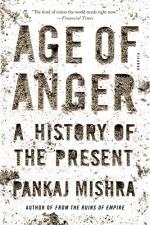|
This section contains 507 words (approx. 2 pages at 400 words per page) |

|
Age of Anger Summary & Study Guide Description
Age of Anger Summary & Study Guide includes comprehensive information and analysis to help you understand the book. This study guide contains the following sections:
This detailed literature summary also contains Topics for Discussion on Age of Anger by Pankaj Mishra.
The following version of this book was used to create the guide: Mishra, Pankaj. Age of Anger. Macmillan, 2018.
Pankaj Mishra’s book is divided into seven chapters, only one of which -- “Regaining My Religion” -- is further divided into two sections. Each chapter of the book attempts to address a given period in history and some corresponding trends in intellectual thought, all pertaining to the origins of today’s global crisis. In attempting to explain the rise of far-right parties, militant nationalism, and terrorism, among other phenomena, the author embarks on a lengthy and, for the most part, chronologically coherent journey from the eighteenth century to the present day.
The first chapter, “Prologue: Forgotten Conjectures,” the author puts forward his argument that the rise of liberal capitalism and cosmopolitan liberalism in the eighteenth century produced events and consequences whose ramifications are felt today through the widespread discontent we see. He briefly touches upon intellectuals whom he quotes throughout the book, such as Rousseau. The second chapter, “Clearing a Space: History’s Winners and Their Illusions,” takes a deeper look at the Western institutions and assumptions prevailing in today’s world order, pointing out their origins in Revolutionary France and indicating that the myths and ideas upon which the world order was built was never as well-functioning or egalitarian as it was made to seem. Thus, the dichotomy of the West and non-West extends back centuries and is grounded in Enlightenment ideals to a large extent.
The third chapter, “Loving Oneself Through Others: Progress and Its Contradictions,” dives into the subject of mimetic rivalry, or the process by which non-Western countries, often former colonies, struggled and continue to struggle with feelings of material envy and the desire to modernize in a way similar to the West. The projection of Western ideals onto non-Western spaces caused numerous national identity crises which were detrimental to proper indigenous development and sovereignty. Then, the fourth chapter, “Losing My Religion: Islam, Secularism, and Revolution,” focuses specifically on former victims of imperial interference, in particular Iran, in order to demonstrate the devastating effects of non-Western elites adopting ‘Western’ values and strategies for development often against the will of the common people, for whom modernization failed to deliver the expected benefits.
The fifth chapter is called “Regaining My Religion” and is divided into Part I, “Nationalism Unbound,” and Part II, “Messianic Vision.” It recounts the rise of national identity as a collective mobilizer and the consequent violence and radicalism associated with its more militant form, in which people believe that they are the “chosen ones” over other groups. “Finding True Freedom and Equality: The Heritage of Nihilism” is the sixth and penultimate chapter of the book, examining violent attempts at anarchist rebellion and the intellectual movement, led by Nietzsche, called nihilism. The final chapter of Age of Anger is “Epilogue: Finding Reality,” which summarizes the main points touched upon in the previous chapters and returns to the present day in order to show the effects of historical movements in the modern world.
Read more from the Study Guide
|
This section contains 507 words (approx. 2 pages at 400 words per page) |

|



